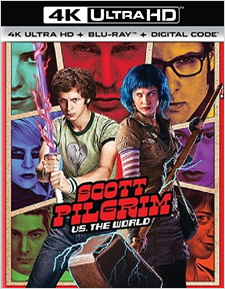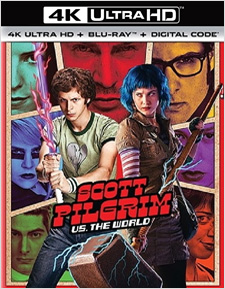Scott Pilgrim vs. the World (4K UHD Review)

Director
Edgar WrightRelease Date(s)
2010 (July 6, 2021)Studio(s)
Universal Pictures Home Entertainment- Film/Program Grade: A
- Video Grade: A
- Audio Grade: A+
- Extras Grade: A+
Review
Scott Pilgrim vs. the World celebrates the joy of filmmaking like few films before or since. Orson Welles famously called the RKO lot “The biggest electric train set any boy ever had," but for director Edgar Wright, making movies is a train set, Lincoln Logs, Tinkertoys, Legos, and an Erector Set all rolled into one. Like Welles before him, Wright delights in exploring the infinite possibilities contained within all of the tools at his fingertips, but unlike Welles, he hasn’t had a studio system trying to beat him back at every opportunity. As a result, he’s had the luxury of refining his skill set on every film, without having to struggle to find the resources to do so.
Scott Pilgrim vs. the World is indeed a refinement of the patented style that Wright had been developing through home movies, episodic television, and his previous features Shaun of the Dead and Hot Fuzz. In fact, that style is perfected here thanks to the ideal source material in Bryan Lee O’Malley’s books. Wright was born to adapt a comic book series, and O’Malley’s visual style was perfectly suited for Wright’s. Chocolate, meet peanut butter. The fact that their senses of humor are also aligned certainly didn’t hurt. This story of a 22-year-old slacker who meets the girl of his dreams—literally, in this case—only to find out that he must first defeat seven of her Evil Exes was a natural for Wright to adapt.
They key to Wright’s filmmaking, and the reason why Scott Pilgrim works so well, is his musicality. Not the scores that he uses, or his famous needle drops, but rather the musical rhythms to his camerawork, editing, and sound effects. Wright doesn’t need music to be musical. Working with cinematographer Bill Pope, editors Jonathan Amos and Paul Machliss, and a legion of sound technicians, every shot is designed to work in coordination to maximize its impact—the whole is greater than the sum of the parts, in the purest sense of Eisenstein’s dialectical montage. Scott Pilgrim vs. the World also benefits from Wright’s impeccable casting, even though some of it is counter-intuitive. Michael Cera’s version of Scott isn’t quite the character as written in the books, and yet he couldn’t be more perfect for the film. Mary Elizabeth Winstead and Ellen Wong are also perfect as Ramona and Knives, but it’s the supporting cast which steals nearly every scene. Anna Kendrick, Kieran Culkin, Allison Pill, Aubrey Plaza, Jason Schwartzman, Chris Evans, Brie Larson, Brandon Routh, Clifton Collins, Jr., Thomas Jane—how does one choose a favorite out of such an embarrassment of riches?
Wright and co-screenwriter Michael Bacall were a bit hampered by the fact that the film went into production before O’Malley had even finished the books, so they had to choose an ending for themselves. Hedging their bets, Wright actually shot two different versions. The ending which made the final cut won’t please everyone, but in the long run it works best for all of the characters involved. The one who’s left behind does so by her own choice, and has grown all throughout—she’s earned her independence. The one who goes with Scott has grown in a different way, and being with him is probably a positive move for her. After all, he has finally faced his own faults and learned to accept himself, which is a major point of difference with all of the other male characters in the film.
Bill Pope shot Scott Pilgrim vs. the World on 35 mm photochemical film using Panavision Panaflex Millennium XL2 cameras and Panavision anamorphic lenses, with some additional live action photography accomplished in Super 35 format using Arriflex 435 ES cameras with spherical lenses. Visual effects material was shot on 35 mm film horizontally in VistaVision format using a Beaumont camera with Leica lenses, while further high-speed photography was captured digitally using a Phantom HD camera. After extensive post-production, the film was then finished as a 2K Digital Intermediate framed at 1.85:1 for its theatrical release, with occasional 2.35:1 sequences letterboxed within that frame. For its debut on Ultra HD, that DI was upscaled to 4K and the resulting image was then graded for high dynamic range (both HDR10 and Dolby Vision options are available on the disc). According to Wright, the entire process of remastering the film for 4K was supervised by the original team of sound mixer Julian Slater, colorist Stephen Nakamura, DP Bill Pope, editor Paul Machliss, and Wright himself. It’s normal to see small but noticeable improvements in fine detail with 2K upscales compared to 1080p Blu-ray, but in this case the improvements are drastic. While many of the visual effects shots still look a bit soft, everything else is sharp and detailed, with the grain appearing much more even and natural than it did before. There’s no other information available about the transfer, but it’s likely the remastering team went back to the original negative for the live action elements (not containing visual effects), so that material may very well be native 4K. Unsurprisingly, the HDR grade really dazzles, with brilliant colors, improved contrast, and deeper black levels. This film was made for HDR enhancement, and the results don’t disappoint.
Audio options on the 4K disc include English Dolby Atmos and Spanish and French 5.1 DTS, with optional English SDH, Spanish, and French subtitles. (Each commentary also comes with optional English subtitles, but they’re not listed in the main menu.) Universal normally uses DTS:X for its object-based mixes rather than Dolby Atmos, so it’s interesting that they opted for the latter in this case. Regardless of format, the new mix is spectacular—it’s an assault on the senses in the best sense of the term. The style of this film gives plenty of opportunity for expanding elements into the height and surround channels, and they are used here to their fullest, with sound effects moving all throughout the soundstage including the overheads. The bass is deep, especially during the music—when Sex Bob-Omb and the other bands are playing, it sounds as overwhelming as it looks. Scott Pilgrim vs. the World has always had an aggressive sound mix, even in 5.1, and this new version turns everything up to 11.
Universal’s Ultra HD release for Scott Pilgrim vs. the World is a 2-Disc combo pack which includes a copy of the original Level Up! Collector’s Edition Blu-ray version as well as a Digital Copy code. The good news is that all of the same extras are included on the Ultra HD disc, with the downside being that the Blu-ray doesn’t feature the remastered picture or sound. It also includes an English 5.1 DTS-HD Master Audio soundtrack and no subtitles for the commentaries. The extras include the following, all in HD:
- Feature Commentary with Edgar Wright, Michael Bacall, and Bryan Lee O’Malley
- Technical Commentary with Edgar Wright and Bill Pope
- Cast Commentary #1 with Michael Cera, Jason Schwartzman, Mary Elizabeth Winstead, Ellen Wong, and Brandon Routh
- Cast Commentary #2 with Anna Kendrick, Aubrey Plaza, Kieran Culkin, and Mark Webber
- Deleted Scenes with Optional Commentary by Edgar Wright (21 in all – 27:23)
- Scott Pilgrim vs. the Bloopers (9:39)
- Documentaries: Making of Scott Pilgrim vs. the World (49:32)
- Documentaries: Music Featurette (16:26)
- Documentaries: You Too Can Be a Sex Bob-Omb (2:40)
- Alternative Footage: Alternative Edits (12:20)
- Alternative Footage: Bits and Pieces (6:51)
- Pre-Production: Pre-Production Footage (14:33)
- Pre-Production: Animatics (35:30)
- Pre-Production: Rehearsal Footage (8:48)
- Pre-Production: Props, Rigs and Sets Montage (2:43)
- Pre-Production: Casting Tapes (13:33)
- Pre-Production: Hair and Make-Up Footage (10:46)
- Music Promos: Music Videos (4 in all – 9:38)
- Music Promos: Audio Visual Remixes by Osymyso (7 in all – 9:28)
- Visual Effects: VFX Before & After (14:36)
- Visual Effects: Roxy Fight/Ribbon Version (1:09)
- Visual Effects: Phantom Montage: Hi Speed Footage (3:47)
- Soundworks Collection: Sound for Film Profile (5:40)
- Trailers: Theatrical Trailers (3 in all – 5:30)
- Trailers: TV Spots (18 in all – 7:42)
- Trailers: Video Game Trailers (4 in all – 4:44)
- Adult Swim: Scott Pilgrim vs. the Animation (3:45)
- Scott Pilgrim vs. the Censors (4:10)
- Blogs: Blog One – Introduction (3:35)
- Blogs: Blog Two – First Day of Principal Photography (4:29)
- Blogs: Blog Three – On Location (1:33)
- Blogs: Blog Four – Casa Loma, Fishing and Fatigue (2:23)
- Blogs: Blog Five – From Comic Book Panel to Screen (3:27)
- Blogs: Blog Six – Fight! (3:43)
- Blogs: Blog Seven – Party! (3:12)
- Blogs: Blog Eight – Music! (3:27)
- Blogs: Bonus Blog – Watching the Blogs (2:15)
- Blogs: Blog Nine – Home Sweet Home(s) (3:44)
- Blogs: Blog Ten – Clash at Demonhead (3:04)
- Blogs: Bonus Blog – Frisbee (1:56)
- Blogs: Blog Eleven – Battle Scars (2:52)
- Blogs: Bonus Blog – Hula (2:36)
- Blogs: Blog Twelve – Battle of the Bands (2:52)
- Galleries: Production Photos (56 in all – 9:25)
- Galleries: Edgar’s Photo a Day Blog (320 in all – 53:28)
- Galleries: Johnny Simmons’ Photos (12 in all – 2:05)
- Galleries: Ellen Wong’s Photos (5 in all – :55)
- Galleries: Mark Webber’s Photos (9 in all – 1:35)
- Galleries: Theatrical Posters (10 in all – 1:45)
- Galleries: Fictional Posters (15 in all – 2:35)
- Galleries: Bryan’s Flip Charts (8 in all – 1:25)
- Galleries: Storyboards (377 in all – 62:58)
- Galleries: Conceptual Art Gallery (66 in all – 11:05)
- Galleries: Graphic Novel Comparison Gallery (157 in all – 26:16)
- Galleries: Mecha-Gideon – The Original Boss Battle (19 in all – 3:15)
- Trivia Track
- Disc Credits
This has got to be one of the most overstuffed packages for a home video release ever. It is literally bleeding with content. Kicking things off are a set of four audio commentaries: the first with Edgar Wright, co-writer Michael Bacall, and graphic novel author Bryan Lee O’Malley; the second with Wright and director of photography Bill Pope; the third with actors Michael Cera, Jason Schwartzman, Mary Elizabeth Winstead, Ellen Wong, and Brandon Routh; and the fourth with actors Anna Kendrick, Aubrey Plaza, Kieran Culkin, and Mark Webber. There’s also a set of twenty-one deleted scenes (including a bonus song that didn’t make it into the final film), a set of outtakes entitled Scott Pilgrim vs. the Bloopers, three documentaries and several featurettes, more deleted footage in the Alternative Footage section, pre-production footage, a set of animatics, rehearsal footage, a Props, Rigs and Sets Montage, casting tapes, hair and makeup footage, four music videos, seven OSYMYSO remixes, music promos, visual effects comparisons, a Soundworks Collection: Sound for Film Profile, three trailers, eighteen TV spots, and four video game trailers. Next is an Adult Swim: Scott Pilgrim vs. the World animated segment, the Scott Pilgrim vs. the Censors: TV Safe Version featurette, a set of fifteen video blogs from Edgar Wright which originally premiered on the film’s website, a Galleries section that’s broken up into twelve different areas of interest and contains a total of 998 stills (whew), and a trivia track. All of this material is comprehensive, entertaining, and endlessly informative. It should cover just about anything you would want to know about the film.
Scott Pilgrim vs. the World is a comic book adaptation which manages to do justice to the printed page while still celebrating the film medium in its own way, made by a director, cast, and crew who were firing on all cylinders. Universal’s new Ultra HD release is the best possible way to experience this audiovisual extravaganza. Just remember that gelato isn’t vegan.
- Stephen Bjork
(You can follow Stephen on Facebook at this link)

